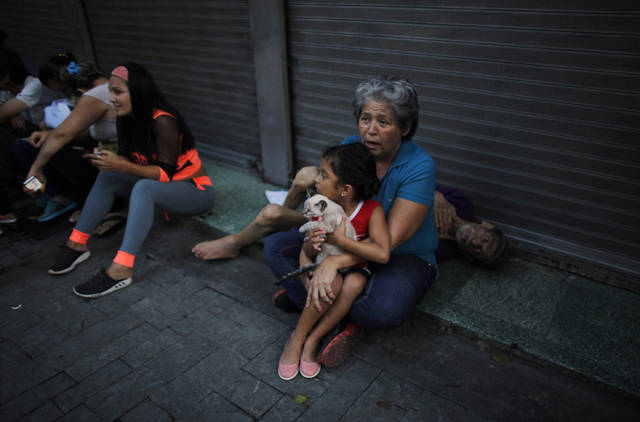CARACAS, Venezuela — A powerful earthquake shook Venezuela’s northeastern coast on Tuesday, forcing residents in the capital to evacuate buildings and interrupting a pro-government rally in support of controversial economic reforms.
The 7.3 quake was the largest to strike Venezuela since 1900, according to the U.S. Geological Survey. But at a depth of some 76 miles (123 kilometers) it appeared to have caused only limited damage even near its epicenter a few miles off the sparsely populated Cariaco peninsula stretching into the eastern Caribbean.
In Cumana, the biggest city near the quake’s center, supermarket shelves came crashing down. At a shopping center, a woman caught in the panic of people rushing out of the building fell on an escalator and injured herself.
In downtown Caracas, concrete from the top floors of the unfinished Tower of David skyscraper fell to the sidewalk, forcing firefighters to close off traffic. A block away, children wearing surgical masks stretched their neck toward the 620-foot (190 meter) building after having fled a nearby foundation for poor children suffering from cancer.
“We felt something strong and they told everyone to run,” said Marisela Lopez, who was at the foundation with her 7-year-old daughter when the quake struck.
Construction of the Tower of David began in 1990 as a symbol to the OPEC nation’s ambitions of becoming a regional finance center. But it was abandoned after a banking crisis and in the past two decades of socialist rule has become a symbol of urban blight, having been occupied by squatters until 2015.
The quake was felt as far away as Colombia’s capital of Bogota, where authorities briefly closed the international airport to inspect for runway damage.
The confusing moments after the quake were captured live on state television as Diosdado Cabello, the head of the all-powerful constitutional assembly, was delivering a speech at a march in support of the socialist government’s recent package of reforms to rescue an economy beset by hyperinflation and widespread shortages.
“Quake!” people yelled as Cabello and others looked from side to side with a mixture of laughter and concern. “It’s the Bolivarian revolution speaking to the world,” Cabello thundered to applause.
A similar-sized quake in the same area left dozens dead in 1997.
But seismologist Lucy Jones, a research associate with the California Institute of Technology, said the earthquake’s considerable depth likely prevented a tragedy.
“Shaking does die off at a distance,” she said, adding that the depth of the quake means there are likely to be fewer aftershocks.
Experts have long warned that Venezuela’s cash-strapped government is ill-prepared to deal with a major natural disaster. Hospitals have scant supplies, many ambulances are grounded and food and water are among goods that have disappeared in a country suffering from inflation estimated by the International Monetary Fund to reach 1 million percent this year.
Interior Minister Nestor Reverol said that disaster relief teams had been activated but so far there were no reports of fatalities.
“We ask for the greatest patience and tranquility from the Venezuelan people,” he said in a televised address. “These situations require prudence.”
Power outages were reported across nearby Trinidad, where people ran into the street and gasped as large glass panes at one supermarket shattered and falling concrete smashed several cars. The quake also cracked walls and thousands of goods fell off supermarket shelves. No injuries or deaths were immediately reported.
The earthquake also was felt in Guyana, Barbados and Grenada.
———
AP Writer Danica Coto in San Juan, Puerto Rico, Tony Fraser in Port of Spain, Trinidad and Christine Armario in Bogota, Colombia contributed to this report.



